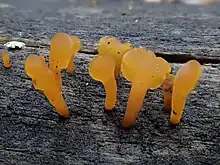Dacryopinax spathularia
Dacryopinax spathularia is a species of fungus in the family Dacrymycetaceae. Basidiocarps (fruit bodies) are gelatinous, frequently spathulate (spoon-shaped), and grow on wood, mainly in the tropics and subtropics. The fungus is edible and is commercially cultivated for use as an additive in the food industry.
| Dacryopinax spathularia | |
|---|---|
 | |
| Dacryopinax spathularia, Australia | |
| Scientific classification | |
| Domain: | Eukaryota |
| Kingdom: | Fungi |
| Division: | Basidiomycota |
| Class: | Dacrymycetes |
| Order: | Dacrymycetales |
| Family: | Dacrymycetaceae |
| Genus: | Dacryopinax |
| Species: | D. spathularia |
| Binomial name | |
| Dacryopinax spathularia (Schwein.) G.W.Martin (1948) | |
| Synonyms | |
|
Merulius spathularius Schwein. (1822) | |
Taxonomy
The species was first described as Merulius spathularius by German-American mycologist Lewis David de Schweinitz based on a collection from North Carolina in the United States. It was moved to the newly created genus Dacryopinax by American mycologist G.W. Martin in 1948 in recognition of its fruit bodies' frequently spathulate shape. Microscopically, however, the species is not typical of the genus[1] and this has been confirmed by recent molecular research, based on cladistic analysis of DNA sequences. Dacryopinax spathularia is not closely related to the type species (Dacryopinax elegans) and belongs elsewhere.[2] It has been placed in a widely defined Dacrymyces,[3] but this latter genus still awaits a comprehensive revision.[4]
Description
The fruit bodies of Dacryopinax spathularia are gregarious, often clustered, and have a distinct stipe (stem) and fertile head that is flattened and fan-like (spathulate) or less commonly palmate. They are tough-gelatinous to cartilaginous and yellow to orange, usually 0.5–2.5 cm (0.2–1.0 in) tall and between 0.3–1.2 cm wide. Microscopically, the species has cylindrical basidiospores that become septate at maturity, measuring 7–11.5 by 3.5–4.5 μm.[1]
Habitat and distribution
Dacryopinax spathularia grows on both rotting coniferous and broadleaf wood; it has even been reported to grow on polyester rugs.[5] It is widely distributed in Asia, Africa, Australia and the Pacific, North and South America, but is not known from Europe.[1]
Economic Usage
Dacryopinax spathularia is edible.[6] The species is commercially cultivated to produce long-chain glycolipids used as a natural preservative in soft drinks.[7] The process involves fermentation of Dacryopinax spathularia using glucose as a carbon source in aerobic submerged culture.[8]
In China fruit bodies are called guìhuā'ěr (桂花耳, literally "sweet osmanthus ear," referring to their resemblance to osmanthus flowers). They are sometimes included in a vegetarian dish called Buddha's delight.[9]
References
- McNabb, RF (1965). "Taxonomic studies in the Dacrymycetaceae: III. Dacryopinax Martin". New Zealand Journal of Botany. 3 (1): 59–72. doi:10.1080/0028825X.1965.10432062.
- Zamora JC, Ekman S (2020). "Phylogeny and character evolution in the Dacrymycetes, and systematics of Unilacrymaceae and Dacryonaemataceae fam. nov". Persoonia. 44: 161–205. doi:10.3767/persoonia.2020.44.07. PMC 7567964. PMID 33116340.
- Alvarenga RL, Gilbertoni TB (2021). "Insights on the morphological and phylogenetic delimitation of Dacrymyces Nees". Research Square. doi:10.21203/rs.3.rs-950799/v1. S2CID 244824265.
- Zamora JC, Savchenko A, González-Cruz Á, Prieto-García F, Olariaga I, Ekman S (2022). "Dendrodacrys: a new genus for species with branched hyphidia in Dacrymyces s.l., with the description of four new species". Fungal Systematics and Evolution. 9: 27–42. doi:10.3114/fuse.2022.09.04. PMC 9355100. PMID 35978985.
{{cite journal}}: CS1 maint: multiple names: authors list (link) - Hemmes DE; Desjardin D. (2002). Mushrooms of Hawai'i: An Identification Guide. Berkeley, California: Ten Speed Press. p. 79. ISBN 1-58008-339-0.
- Boa E. (2004). Wild Edible Fungi: A Global Overview Of Their Use And Importance To People (Non-Wood Forest Products). Food & Agriculture Organization of the UN (FA. p. 134. ISBN 92-5-105157-7.
- "Nagardo® The natural guardian for beverage quality". Retrieved 2022-11-02.
- EFSA Panel on Food Additives and Flavourings (2021). "Safety evaluation of long-chain glycolipids from Dacryopinax spathularia". EFSA Journal. 19 (6): e06609. doi:10.2903/j.efsa.2021.6609. PMC 8201184. PMID 34140988.
- Meuninck, Jim (2017). Foraging Mushrooms Oregon: Finding, Identifying, and Preparing Edible Wild Mushrooms. Falcon Guides. p. 74. ISBN 978-1-4930-2669-2.